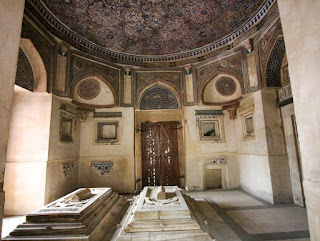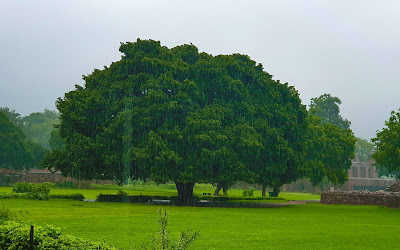Mehrauli Archaeological Park
We visited Mehrauli Archaeological Park on 4th August 2019, the
access to this is from Mehrauli-Gurgaon Road, just off the Qutub complex. The
park mainly contains Tomb of Balban, Quli Khan Tomb, Jamali-Kamali Masjid,
Metcalfe Canopy etc.
Tomb of Balwan
It was narrated by Ibn Batuta that one day in Bukhara, a sufi dervish
asked a young, not a good-looking boy, to bring an orange for him. The boy got
one orange purchased and brought to the dervish, who became very happy and
blessed him that I have given you the sultanate of Hindustan (India) to you.
Later after several years, hundreds of slaves were brought before
Iltutmish, then the king of Delhi. He purchased all but one – the same boy from
Bukhara. That slave asked the king who do you purchase these slaves for? "For my own use", was the reply of Iltutmish. He then requested why don’t you purchase me
too for Allah. Iltutmish became very happy with the reply and purchased him
too.
That slave worked in the court of Iltutmish and awarded the work of
filling water. Later, he rose through ranks and became one of 40 esteemed
viziers of Iltutmish. That boy from Bukhara was the same slave and was known as Ghiyasuddin Balban (1200-1287), one of
the most powerful sultan of sultanate period. Balban was deputy to Nasiruddin
Mahmud (1246-1266), who was also his son-in-law. He was effectively running the
kingdom and then he became king after Mahmud’s death in 1266 and reigned till
his death 1287. He considered himself as the descendants of mythical Persian
kings and used to lofty standards. It is said that no one has seen him in
laughing or jovial mood and he used to be serious always and had broken the
back of elite courtiers, who were hitherto very powerful. It is also said that he always used to be in his
formal royal dress.
His tomb lies in the Mehrauli Archaeological park in a quite dilapidated condition. It was in
the midst of an old settlement, the ruins of which were evident while
approaching the tomb. It is said that he got erected a structure, known as
Dar-ul-Aman (Place of Peace), where anyone can enter and put his problem, which
will then become the problem of the state and got resolved. Therefore, in a
way, people could get their problems resolved and lived in peace, hence Place
of Peace. It is the same place where Balban was buried. It is also considered
that his elder son Muhammad, known as Khan Shahid, was also laid in the
adjacent chamber, who got killed in Multan fighting Mongols in 1285. Balban
liked his elder son very much and his death broke him down and could not be able to
live a year or so more. The structure is, though imposing rubble masonry, in
complete ruin and even the approach road is through bushes and no proper
pathway has been made. The structure was built of quartzite, which is locally available
stone.
Jamali-Kamali Mosque
There are two structures by this name situated adjacent to each
other– one is a mosque and another a mausoleum. The mausoleum complex contains a number of graves and a covered grave of
Jamali-Kamali. The interior of the chamber is quite ornamented but was not allowed
to enter. It was considered that Shaekh Fazlullah was a sufi saint and was
popularly known as Jamali. He was contemporary of Sikandar Lodi to Babur and
Humayun. The antecedents of Kamali is not known but was associated with Jamali
and are buried adjacent to each other. The graves inside are of marble and intricate
carvings and letters engraved are legible. The graves in the complex are in
good condition with engravings clearly visible. It was built during 1528-29.
The mosque is adjacent on the south of the tomb and is a wonderful
example of Indo-Islamic architecture. Red sandstone, Marble and local quartzite
stones are used in the mosque. The inner main prayer chamber has beautiful
carvings and few Quarnic verses are engraved, which are still clearly legible. The
floor is in square shape, whereas the roof is circular, a great piece of
symmetry and architectural marvel. The mosque has five arches and the middle
one is the largest and the most decorated. The mosque is huge, imposing and architecturally
pristine. It is believed to be constructed during 1528-29. You would feel a
sense of serenity while entering the mosque, which I felt there.
Tomb of Quli Khan
Moving towards North from the Jamali-Kamali mosque, one passes
through beautifully profiled and maintained gardens on either side. One would
reach this tomb site though a long culvert, which was constructed by Thomas
Metcalfe, a British officer in Delhi. It was believed that he got constructed
an artificial lake around the Quli Khan Tomb and culvert was the passage over
the lake. He also used to visit the sites on boats.
The tomb of Quli Khan is an imposing structure of octagonal in same,
placed on a raised pedestal. The gates of the tombs are intricately engraved
with Quranic verses. Muhammad Quli Khan was the brother of Adham Khan, son of
Maham Anga, the wet nurse of emperor Akbar. It was built in 17th century.
Later the structure converted into a picnic retreat by Thomas
Metcalfe, who enlarged the structure, creating lake in surroundings, water
courses and pavilions. He named it as Dilkhusha (the pleasure of heart). He also
got constructed a number of Follies and canopies nearby, one of which is intact
in the park opposite Jamali- Kamali mosque.
Ideal time to visit
Places not to be missed
(with link to Wikipedia page)
Ideal time to visit
- Can be visited any time, preferably forenoon, round the year.
- One needs to be ready with sports shoes, full sleeve shirt and water bottles.
- No tickets in any monument.
Places not to be missed
(with link to Wikipedia page)
- Balban's Tomb
- Settlement around Balwan's tomb
- Jamali-Kamali Mausoleum
- Jamali-Kamali Mosque
- Quli Khan's Tomb
- Metcalfe's addition to Quli Khan's tomb
- Metcalfe's Canopy
- View of Qutub Minar from the park
Some timelines
Time Period
|
Reigns
|
|
Balban’s
Tomb
|
1287
|
|
1528-29
|
Sikandar Lodi, Babur, Humayun
|
|
1528-29
|
Sikandar Lodi, Babur, Humayun
|
|
Tomb of Quli Khan
|
17th Century
|
Akbar
|
Nearest Metro Station - Qutub Minar (on Yellow line)
Gallery















Well narreted. Meticulously summed up covering all the details. I wish photos of monument are uploaded soon.
ReplyDelete-Shailesh